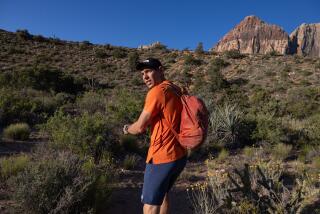At 74, ‘Peak Bagger’ Still Has Lofty Goals
- Share via
SALT LAKE CITY — It doesn’t take a rocket scientist to climb the highest peaks in every state.
However, Salt Lake City’s Roy Macpherson is a retired rocket scientist who started climbing high points in 1984, when he was a young fellow of 58 and “peak bagging” was popular.
There’s little doubt that his science background and attention to detail are what helped him to study maps and conquer all but one of the nation’s 50 high points.
The one peak that remains is the most remote and difficult--Mt. McKinley in Alaska.
Macpherson, 74, is among an elite group of only about 110 people in the United States who have climbed 49 peaks.
He has been hiking since his Boy Scout days in Colorado.
He decided, with two years to go in his career as a rocket-engine engineer for Hercules Inc., then a Utah defense contractor, that climbing all the Western states’ high points would be a challenging, yet attainable goal. Mt. Rainier was his first climb, on July 22,1984.
He then scaled summits in the other 10 Western states, completing the last, California’s Mt. Whitney, on July 17, 1990. All three of his sons went along on that one.
It wasn’t until 1989, when Macpherson had just three of those 11 Western high points to go, that he heard about the High Pointers Club, which was just beginning to take off and now has thousands of members.
He joined the club, and that helped him complete the generally easier high points in the East.
His hardest overall climb, he said, was Gannett Peak in Wyoming’s Wind River range. Although only 13,804 feet high, it took him three attempts to reach its summit.
The first time he said he wasn’t properly prepared, and the second time the weather didn’t cooperate, dumping six inches of fresh snow. Even his final, successful ascent of Gannett, a multiday backpack trip of some 40 miles, wasn’t that easy.
“I thought I was going to die,” he said.
Mt. Rainier was his second hardest climb.
He considered climbing McKinley, but said the $17,000 price tag and four to six weeks required for the climb stopped him.
Not All Summits Were High Points
Macpherson believes prospective high pointers would be wise to join the national club and they shouldn’t let the technical climbs, where they must use climbing equipment, scare them away.
“Technical climbing is very safe if you do it properly,” he said.
His wife, Sydna, has supported him in his climbing endeavors and has accompanied him to 30 of the high points.
Family members and friends went along on other climbs, but on some, like Idaho’s Mt. Borah and Maine’s Mt. Katadin, he went alone.
All the trips to the summits were fun, he said, including the one in Florida, reachable by car, and Delaware’s, located in the middle of a two-lane paved road.
He continues to stay in shape, hiking three or more times a week in the Salt Lake area mountains and also biking with his brothers.
He admits he’s had to slow down in recent years, but that’s why he did the highest and hardest high points first.
Why climb high points? It’s not just because they’re there, he said.
“First, I get a kick out of planning and scheduling climbing. . . . When you are at the trailhead you frequently have aches and pains, but these all seem to go away after you have hiked 20 or 30 minutes. Something chemical happens in your body, maybe the release of endorphins, and you just feel great,” Macpherson said.
More to Read
Sign up for The Wild
We’ll help you find the best places to hike, bike and run, as well as the perfect silent spots for meditation and yoga.
You may occasionally receive promotional content from the Los Angeles Times.






